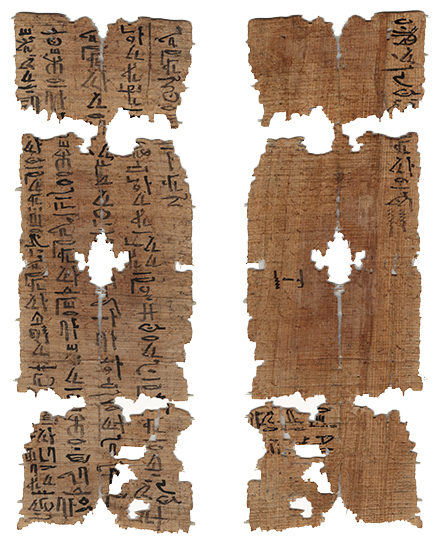22 Ancient Egyptian

Ancient Egyptian is a language that was spoken in and around the Nile River valley from the 4th millennium BCE through the 11th century CE. The earliest form of this language was written in the Hieroglyphic script. Soon after the development of Hieroglyphs, the availability of papyrus as a light, portable writing material and the complexity of drawing complete Hieroglyphic signs led to the development of Hieratic. This cursive form of the ancient Egyptian script is what an individual named Heni used to write a letter to his deceased father, Meru, sometime between 2160 and 2025 BCE. Heni’s composition is one of a handful of texts known as “Letters to the Dead,” which have been found throughout Egypt written on materials as diverse as pottery, figurines, linen, and stone stelae. Although this genre of text is attested for a period of nearly two thousand years, only a handful of examples survive, all of which share the common goal of communicating a wish or desire from the living to the dead.
The letter of Heni, written in vertical columns, as was typical for Hieratic of this time period, opens with a greeting to Meru before imploring him to intercede on his son’s behalf and offer aid. Heni believes he is being falsely accused of harming someone, insisting the wrong was instigated by other parties. Unfortunately, the details of the event are lacking. These letters are frustratingly vague, as it was assumed that the intended audience — usually a close relative or acquaintance — knew the specifics of the situation. The letter was folded and addressed like letters sent among the living. That is to say, the address was written on the outside (the two short lines written horizontally towards the bottom of the verso of the papyrus): the nobleman (iry-pat), count (haty-a), overseer of priests, Meru. In order to ensure the message was delivered, Heni deposited the small papyrus in his father’s tomb. Whether or not his father (or the living judges) recognized his plea of innocence, we will never know.
Several millennia later, Heni’s papyrus was found during the archaeological excavations of George A. Reisner. Working under the patronage of Phoebe A. Hearst, Reisner excavated the site of Naga ed-Deir between 1901 and 1904. The letter was found in the tomb of Meru (N.3737), which was decorated with images of him enjoying everyday life. The papyrus was shipped by Reisner to Germany for conservation, where it remained until after World War II. When financial difficulties compelled Phoebe Hearst to withdraw funding for the Berkeley Egyptian Excavations in 1905, George A. Reisner was appointed to the faculty at Harvard University and to the curatorial board at the Museum of Fine Arts (MFA), Boston. A young, enterprising curator at the MFA, William Kelly Simpson, knew of papyri excavated by Reisner and later sought them out in Germany. With Simpson’s help, the papyrus — along with several others — traveled from West Berlin to the MFA. After securing them in Boston, Simpson published the first translation of this text. Despite earlier inquiries from faculty at UC Berkeley, it was not until the 2000s that Professor Donald Mastronarde of the Berkeley Department of Classics ascertained the whereabouts of these papyri and engineered their return to Berkeley. The Letter to the Dead, along with numerous other ancient Egyptian papyri, are now housed in the Center for the Tebtunis Papyri at The Bancroft Library, as part of the Egyptian collections acquired by Phoebe A. Hearst between 1899 and 1905.
Courses in Ancient Egyptian are taught at UC Berkeley in the Department of Near Eastern Studies as part of a program in Egyptology. Students can take classes in several phases of the language, including Old, Middle, and Late Egyptian, and Demotic.
Emily Cole, Postdoctoral Scholar
The Center for the Tebtunis Papyri, The Bancroft Library
Source consulted:
Simpson, William Kelly. “The Letter to the Dead from the Tomb of Meru (N 3737) at Nag’ Ed-Deir.” The Journal of Egyptian Archaeology, vol. 52, 1966, pp. 39–52. JSTOR.
Author: Heni
Registration Number: Papyrus Hearst 1282
Imprint: 9th or 10th Egyptian Dynasty. First Intermediate Period (Between 2160 and 2025 BCE)
Language: Ancient Egyptian
Language Family: Afro-Asiatic, Semitic
Source: The Center for the Tebtunis Papyri, The Bancroft Library (UC Berkeley)
URL:http://dpg.lib.berkeley.edu/webdb/apis/apis2?invno=P%2eHearst%2e1282&sort=Author_Title&item=1

